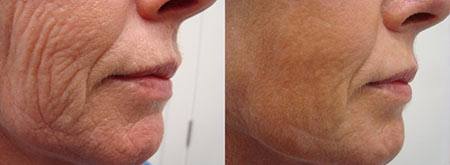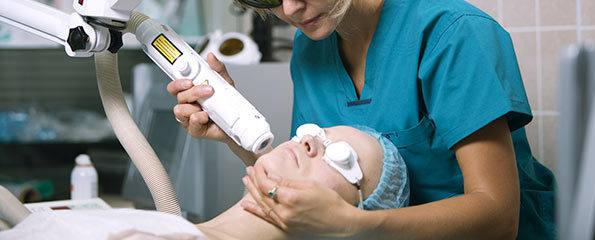Q & A- What do I need to consider before Laser Skin Resurfacing?
Reader question:
My skin is badly wrinkled. I’ve spent plenty of time in the sun over the years and I also used to smoke. I’m tired of having wrinkled skin, it looks old and makes me feel old. I want to change the appearance of my skin. I’ve been reading about different ways of reducing wrinkles and have read laser skin resurfacing may help. But I haven’t been able to find out much about what the procedure involves and what the risks are.
 Cosmetic Surgeon response:
Cosmetic Surgeon response:
Dr Daniel Lanzer, MB BS (HONS) FACD, Specialist Dermatologist – Australasian College of Dermatology FACD, Australasian Academy of Facial Plastic Surgery (AAFPS), Cosmetic Laser & Liposuction Surgeon at Monash University, Member of American Academy of Cosmetic Surgery (AACS) & Fellow of Australasian College of Cosmetic Surgery (ACCS)
What Is Laser Skin Resurfacing?
Laser skin resurfacing is a cosmetic surgical procedure. It is often called a skin rejuvenating procedure and is used by people who want to reduce the appearance of wrinkles, fine lines or visible scars.
Laser skin resurfacing is a type of cosmetic (plastic) surgery that falls under the category of photorejuvenation.
Skin rejuvenating procedures can be classified into:
- Thermal (including laser skin resurfacing);
- Chemical (commonly referred to as a ‘chemical peel’),
- Mechanical (e.g. dermabrasion);
- Injection (including anti-wrinkle injectables); and
- Light treatments (in which intense beams of light are applied to the skin).
What does laser skin resurfacing do?
Laser skin resurfacing is a thermal photorejuvenation technique, that removes old skin cells using heat produced by a laser. The skin resurfacing procedure removes the outer layers of the skin. This stimulates the body to create new skin cells, which can change the appearance of skin and reduce the appearance of wrinkles, scars and other irregularities. The laser technique also heats the underlying skin layers and causes the collagen fibres which bind skin together, to tighten, giving skin a more toned look. It’s important to be aware that the procedure will not make your skin look young again, and it won’t prevent future ageing. But it can reduce the appearance of wrinkles.
There are two main types of lasers that can be used to execute the procedure, the carbon dioxide laser and erbium laser. The type of laser used depends on the surgeon performing the procedure and the country where you obtain the treatment. In general, the erbium and carbon dioxide laser are quite similar where treatment and results are concerned. Therefore, the choice of the laser is usually made based on a recommendation from your cosmetic surgeon.
Laser skin resurfacing is sometimes used in combination with a facelift or eyelid surgery.
It’s important to talk to several surgeons, and consider their qualifications and experience, before you make a decision about having laser skin resurfacing. The laser skin resurfacing procedure should be executed by a certified cosmetic surgeon or a dermatologist. For more information see choosing a cosmetic surgeon.

Image courtesy of Dr Lanzer
What are the Risks of Laser Skin Resurfacing?
Laser skin resurfacing treatments are generally safe when completed by a board-certified cosmetic surgeon or dermatologist. However, anyone considering the procedure should be aware that laser skin resurfacing complications (such as abnormal healing and infection, though quite rare) do arise. It is important that you are aware of these risks before you consider undergoing the procedure.
Laser resurfacing could cause burns or other injuries that originate from the heat of the laser. Even though the medical staff at your treatment facility will try to reduce these risks, there is always a chance. Rarely the eyelids are affected, and change shape to turn outwards following laser skin rejuvenation near the eyes. This condition called ectropian requires surgical treatment.
There are also less serious risks including temporary or permanent scarring, especially in those who are prone to scar easily. Permanent darkening of the skin or hyperpigmentation is a protuberant risk for darker skinned patients seeking to endure the procedure. An erbium laser procedure has a slightly lower risk of permanent skin discoloration versus a CO2 laser peel treatment. Your Cosmetic Surgeon may prescribe an over-the-counter bleaching cream before undergoing a laser skin resurfacing treatment to prevent the possibility that this will happen. Permanent lightening of skin or hypopigmentation is also a likelihood, though this is of a lower risk.
Undergoing the procedure also makes people more prone to outbreaks of cold sores or acne, and some people experience skin itching after the procedure. There is also a risk of viral, bacterial and fungal infections following the treatment (including cold sores which are caused by herpes simplex virus). You may not experience any of these complications, however you need to be aware that there is a risk.
Who is not a suitable candidate for laser resurfacing?
- People who are prone to scarring after a minor injury shouldn’t undergo laser skin resurfacing as it may damage their skin.
- People with acne, cold sores, as well as other skin disorders can become worse after laser resurfacing so they must first speak with their dermatologist.
- Smoking decreases the capacity of the damaged skin to heal, hence smokers will need to quit at least two weeks earlier and two weeks’ post laser skin resurfacing.
How to Prepare for a Laser Skin Resurfacing Procedure?
If you decide laser skin resurfacing is the right procedure for you, there are some things you’ll need to do in order to prepare for the procedure. It is important to begin by discussing your medical history at length with your dermatologist before undertaking laser skin rejuvenation. Drug allergies, medical conditions, specifically connective tissue as well as immune disorders, medications and any previous skin treatments, predominantly chemical peels are potential foundations of laser skin resurfacing complications.
Your surgeon will need to know things like your history of allergies and other skin conditions like fever blisters or cold sores. Even if you only had minor skin problems, it is essential to report them to your doctor. Also tell your doctor if you have any medical condition, if you are pregnant or breastfeeding or if you have had other cosmetic skin procedure like a chemical peel or dermabrasion in the past.
Tell your doctor about any medications or complementary therapies you are using, as some medications increase the risk of complications during surgery, and may need to be changed before you undergo laser skin resurfacing. Some of the supplements and medications that could increase the risk of complications during the procedure are aspirin, ibuprofen and vitamin E. These products influence blood clotting, and may increase the risk of bleeding during surgery or delay your recovery subsequently. Your surgeon should give you a list of medications and supplements you need to avoid at least 10 days before the procedure. It is also essential that people preparing for laser skin resurfacing stop smoking. Smoking may slow down the recovery process and also make the skin age faster, undoing the results of the treatment.
Your medical team may also recommend that you take medications or supplements before your procedure is performed. Patients who are prone to cold sores and fever blisters might be prescribed some antibiotic or antiviral medication; this to avoid outbreaks after the skin resurfacing procedure. It is also recommended that you avoid sun exposure as much as possible for up to two months before the procedure.
And because the surgery requires an anaesthetic, you’ll need to organise someone to help you get home after the procedure.
How much does laser skin resurfacing cost?
You’ll also need to prepare for the costs of laser skin resurfacing. Cosmetic treatments are generally not covered by Medicare, except in very rare situations where a cosmetic issue is affecting the health of a patient. However, cosmetic procedures may be covered under your health insurance, more precisely under a health cover plan with a private health insurer.
The amount of coverage you can attain for cosmetic procedures will be contingent on your health insurance plan and your overall annual limit. Cosmetic procedures generally fall under extras, so it is vital to check your annual limit to gauge how much you can claim back on your cosmetic treatment. Some cosmetic surgeons also have payment plans but they require full payment to be completed on the day of the operation.
Don’t go overseas it’s dangerous for cosmetic procedures. Poorly performed procedures overseas can lead to serious difficulties. Most cosmetic surgery facilities abroad don’t give you a worldwide guarantee, meaning you can’t take advantage of an Australian cosmetic surgeon if something does go wrong. Most Australian cosmetic surgeons will also be cautious and hesitant to correct a problem that has been caused by a surgeon abroad, additionally you will also have to pay for this correction. In the end, it may cost you more than if you had the cosmetic procedure in Australia in the first place.
What Happens During the Laser Skin Resurfacing Procedure?
To prepare you for surgery the surgeon will place a protective cover over your eyes. This will remain there for the duration of the procedure, to prevent the laser from burning your eyes during the procedure.
For most treatments, the cosmetic surgeon will use a local anaesthetic, to numb the area of skin on which the surgery will be performed. A local anaesthetic is typically used because only small parts on the face need to be treated. However, the surgeon may also use a general anaesthetic if laser skin resurfacing will be performed on a large area of skin. Once the anaesthetic is applied the surgeon will clean the skin which will be operated on.
When the anaesthetic takes effect, the surgeon uses the laser to direct heat to the skin irregularity you are trying to change. The procedure usually takes 30 minutes to two hours, and often needs to be repeated on several occasions, spread weeks apart.
What Happens After the Procedure?
Following the procedure the skin will be raw, swollen and itchy. You will need to keep the skin area affected by the surgery as clean as possible. The surgeon will provide you with a special ointment or recommend a product for the aftercare of your skin. They may apply a dressing to cover the wound. You will need to avoid the sun and may need to avoid strenuous exercise (discuss this with your surgeon) and should expect to need to care for the wound for 1-2 weeks, until new layers of skin grow. It is recommended to clean the treatment area five times per day with saline or diluted vinegar and apply a special ointment that will hydrate the skin.
You should expect some side-effects after laser skin resurfacing. Most people who have the procedure experience swelling. Using an ice pack and lifting your head with an extra pillow at night can help reduce swelling. The swelling dissipates over time, but redness and swelling may persist for months, and you won’t notice the changed appearance of your skin until you’re over these side effects. Even once the skin has healed, you need to be vigilant about protecting it from the sun and not smoking.
Follow up Care
Your cosmetic surgeon will give their patient instructions for the immediate care they require after their cosmetic surgery. Follow-up procedures are essential for the best results. The recovery time from laser resurfacing will vary depending on the patient and device used; in general it is 7 days off for the skin to peel and recover. A healing cream/ointment is required for 5 days and makeup may be applied at Day 7 to help conceal the pinkness. Sun exposure must be minimised for a month after the procedure.
Dates
Tags
Created by:

 Login
Login














